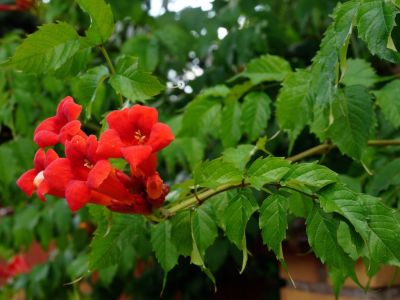Trumpet Vine Problems
Only a few diseases attack trumpet vine, and you can take action to prevent or control them before they become a problem. The diseases of trumpet vines can be counted on one hand. These resilient flowering vines generally thrive with little care across a wide spectrum of climates, including U.S. Department of Agriculture plant hardiness zones 4 through 10.
Powdery Mildew
Perhaps the most prevalent of the diseases of trumpet vines is powdery mildew. This is a fungal disease that affects many ornamental plants, caused by over one thousand different fungi species. Powdery mildew is certainly one of the trumpet vine diseases that is easiest to identify. If your trumpet plant is infected, you will see a powdery coating – white to gray – on the plant’s foliage. Powdery mildew trumpet vine diseases first show up as patches of fungal growth on infected portions of the leaves. As the infection progresses, the fungus completely covers the leaves and the white fungi darken to gray or tan. An ounce of prevention is the easiest way to deal with powdery mildew. You should provide the plant with good air circulation, keep it healthy, and destroy infected leaves. Chemical fungicides are a weapon of last resort for severe infections.
Leaf Spot
Trumpet vines are also susceptible to various leaf spot infections, but these are not a very great threat. Consider them minor problems with trumpet vines. Recognize them if you see small, spots on your plant’s foliage. Controlling trumpet vine problems like leaf spot isn’t too difficult. You can often prevent a leaf spot infection on trumpet vines with good garden care. Be sure that the plant has good air circulation and plant it in a sunny location. Even if your trumpet vine is infected, don’t lose sleep over it. Leaf spot infection damage is largely cosmetic.
